
By Nicholas Papa
Ventilation operations vary throughout the country. The differences in tactical approach are typically based on region; culture; and, more functionally, the operational capabilities and the built environment specific to each agency. The situation that produces the most disparity (and contention) is ventilation at fires involving peaked-roof dwellings. Although conditions and resources are legitimate deciding (limiting) factors, often, we allow organizational norms (bias) to impact tactical decision making on the fireground. The insulated mindset of “We’ve always done it that way” or “We just don’t do that here” may not correlate to best practices—those rooted in logic and validated by experience and data. This mentality is often an indicator of a lack of understanding or, at the very least, closed-mindedness.
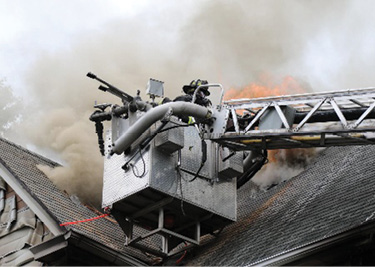
(1) The tower ladder sticks the valley, granting access to multiple sections of the roof, allowing the firefighters to cut both sides from the bucket. (Photo by Patrick Dooley.)
Overhaul is Ventilation: Providing Air to Concealed Spaces: Nicholas Papa
As professionals and, most importantly, public servants, it is our duty to ensure we are organized and deploy for maximum effectiveness and efficiency. We must execute our operations in the manner that affords civilians (and their property) the highest level of protection and the best chance of survival. Doing so requires an in-depth assessment of your working environment as well as your operational capacity and the full array of tactical options to address your needs. Only then can you develop the knowledge base and understanding to identify those that are compatible with your organization and community. Doing so not only narrows the selection process, streamlining operations, but it inherently increases the chances of success on the fireground.
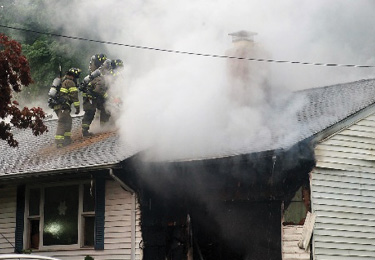
(2) If the vent hole does not have a direct pathway to the fire, it will not be effective in aiding the extinguishment effort. (Photo by Michael Carenza Jr.)
Vertical Ventilation
When evaluating the nature of fire behavior and air movement, fireground ventilation is irrefutably most effective when conducted by way of vertical channels (where applicable). Because heat rises, gases expand, and air moves from areas of high pressure to low pressure, the by-products of combustion are most efficiently removed by an opening created directly above the area of involvement. “Conditions will improve because you are letting the heat and smoke out the fastest way possible; that is the biggest pressure differential. It is going to move out, using the buoyancy of the gases, and make things better, but it has to be coordinated.”1 When properly timed with the engine company’s progress, the impact of topside ventilation makes it the preferred exhaust opening for the attacking crew making the push. “You could not ask for a better hole to advance towards with an open and flowing nozzle.”2 Serving as a dedicated outlet, vertical ventilation maximizes the exhaust potential and lift of the thermal balance—improving visibility and providing relief for firefighters and potential victims alike.
That being said, however, things are not always so cut and dried. There are many variables and complications you must consider before committing to vertical ventilation at peaked-roof dwellings. First and foremost, the location of the fire is the most prominent deciding factor when venting for extinguishment. Vertical ventilation is most effective when the fire is in the attic space. Creating a direct pathway from the opening to the area above the fire will ensure that the heat and smoke are exhausted in the most efficient manner. “A roof opening of adequate size with an unobstructed channel from the involved atmospheric area provides an ideal opening.”3 Additionally, the reduced fuel load frequently encountered in the attic space, largely composed of wooden structural members and decking, can increase the confinement ability of the vent opening created. This is a tremendous benefit, as most attic spaces are not compartmentalized and lateral fire spread is a chief concern.
As with most things on the fireground, this benefit is not a guarantee. Walkable attic spaces, predominantly those in private dwellings or older multiple dwellings with steeper roof pitches, can be used as an additional living space (creating knee walls and other voids) or, more commonly, for storage; this is largely dependent on the size of the space. With large plastic totes being one of the most popular means of storing items (usually holiday decorations, clothes, and toys), the fuel load can easily match or even exceed that of a living space, requiring they be addressed accordingly.
Although vertical ventilation can be effective also for fires involving the floor beneath the attic, it presents some inherent challenges and considerable drawbacks. If the attic is not involved, cutting a hole in the roof and penetrating the ceiling below will bring the smoke and fire through that previously uninvolved space—requiring more stringent timing. “If the fire is not in the attic, vertical ventilation will bring it there—making it a structure fire.” (1) This can result in excessive property damage if sufficient windows are available to effectively vent the fire on that level. Furthermore, the opening made in the ceiling may not match the size of the hole cut into the roof, reducing its exhaust capacity. As soon as the connection between the two spaces is made, the fire will want to begin venting out.

(3) Fire erupts from the vent hole after opening up, causing the roof firefighters to drop back. (Photo by Michael Carenza Jr.)
The Fire Department of New York (FDNY) “Ladders 4” manual on private dwelling operations warns: “Use extreme caution not to be caught by erupting fire once the hole has been opened.”4 The rate at which it does so is conditional and will dictate how long you will be able to operate over the hole to clear the ceiling below. Creating an opening of comparable size within that window of time can be problematic when dealing with plaster and lathe, especially when metal/mesh sheets are used in place of traditional wood furring strips. In the worst-case scenario, the ceiling may not be breached at all because of the presence of decking (typically plywood) placed on top of the joists, creating a walking or storage surface in the attic that potentially can house a large quantity of various combustibles.
The building construction and features must be examined next. For peaked-roof dwellings, the biggest concerns are the roof (steep pitches, lightweight structural members, and tile sheathing); obstructions (solar power systems); access (setback and overhead wires); and height (above the reach of ground ladders).

(4) Steep roof pitches and certain construction styles can be problematic for positioning, and they present challenges for access and cutting operations. (Photo by Patrick Dooley.)
Weather is another factor you must consider. For areas that drop below freezing, snow and ice can be considerable hindrances during the winter months. Significant snow accumulation can create large drifts/banks that may prevent aerial apparatus from getting into functional or ideal positions and can make it difficult for firefighters to maneuver on the ground and even more so on the roof. Additionally, the weight of the snow places an added live load on the roof, further stressing the structural members. These conditions also make traction and footing problematic and increase the likelihood of a slip-and-fall event, which makes the use of roof ladders or operating from an aerial device a necessity.
These components play into the resource requirements, the duration of the operational period, and the ultimate effectiveness of the operation. The more complicated or challenging the environment, the greater the demands will be on your personnel; and subsequently, more lead time will be required to complete the task, increasing the cumulative risk and reducing the probability of successfully coordinating the operation. The background and capabilities of the crews are of particular importance; their level of experience and knowledge base will determine how well they can overcome obstacles.
Pose the following questions before selecting your tactical approach: Does your department have the resources to appropriately contend with the conditions present? Does your department frequently encounter these obstacles? Does your training incorporate these variables? How proficient are the members performing the operation?
When conditions are favorable for venting vertically, the ultimate deciding factor becomes the resources available. The vast majority of fire departments across the country are forced to operate with substandard staffing. Many agencies struggle to simultaneously complete the two primary functions (fire attack and search) as independent operations. “Unnecessary roof venting increases damage and also delays vitally important operations in other areas. Roof venting takes personnel, who, in the early stages of the fire, may have to be committed to search and hoseline operations.”5 Adequately staffing the interior crews is paramount to ensuring the first handline can reach the seat of the fire and the primary search can be completed in the most effective and efficient manner. Fireground commanders must diligently prioritize the tactical objectives and execute the interventions that will have the greatest impact on the strategic priorities based on the conditions and the resources presently at their disposal, maximizing their return on investment and, more importantly, focusing on the mission.6
Horizontal Ventilation
Venting horizontally may not have the same exhaust efficiency as its vertical counterpart, but the results can often be comparable, especially when supplemented postknockdown using hydraulic ventilation. For example, FDNY Deputy Assistant Chief (Ret.) John Norman says, “Generally, if the fire has not extended into the area directly under the roof, then horizontal ventilation will be sufficient.” (4) For the standard contents (compartment) fire, simply taking the windows will provide the necessary relief for the engine company making the attack. FDNY Deputy Chief (Ret.) Vincent Dunn states a similar view: “When firefighters are operating at a private home with a sloping roof, it is more effective to remove smoke from the structure by venting the top floor windows than by cutting a vent opening.”7 By “more effective,” Dunn is presumably referring to the coordination (timing/targeting) and logistical (personnel/equipment) aspects of the operation, as horizontal ventilation is typically much less labor- and resource-intensive.
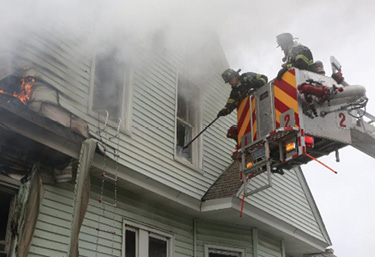
(5) The outside vent firefighter takes an upper-floor window from the bucket of the tower ladder. (Photo by Patrick Dooley.)
Even when the fire is within the attic space, the natural openings present may be enough to do the job, depending on the conditions encountered. FDNY’s “Ladders 4” also states: “Physically cutting and opening the roof is not considered an initial operation at peaked-roof dwelling fires. The venting of attic windows or louvers is frequently sufficient for ventilation purposes.” (4) This is not always the case, however; as the availability/capacity of those openings may not be conducive to such an approach, which would depend on the building construction, fuel load, and level of involvement.
In the case of large/walkable attics, commonly used for storage or as additional living spaces, the fuel load can be drastically increased and the layout altered (compartmentalizing the space). If knee walls are present and the fire has entered into the voids, horizontal ventilation will not ventilate those concealed spaces, allowing fire to spread and superheated gases to dangerously accumulate. “In well-advanced fires in the attic or loft areas, however, roof ventilation may not only be beneficial, it may be a necessity.” (5) Additionally, if signs of a potential backdraft/cockloft explosion are present, Dunn asserts, “Vertical ventilation is one of the most effective methods of preventing or reducing the explosive effects.”8 Select the appropriate avenues to ventilate on a case-by-case basis; the conditions should dictate the actions.
Venting horizontally, however, is not immune to complications and challenges either. In vacant buildings, windows are predominantly sealed up. Traditionally done with plywood or even concrete (cinder) blocks, this practice has evolved, especially in urban areas, to thwart potential intruders/vagrants. Over the past few years, substantial metal coverings, called “Vacant Property Security” systems, and clear acrylic panels have become commonplace. Also present in high-crime areas are window bars, grates/mesh, and brick/block (masonry or glass). These added security measures can be defeated with good technique and the right equipment, but it takes additional time and potentially more resources.
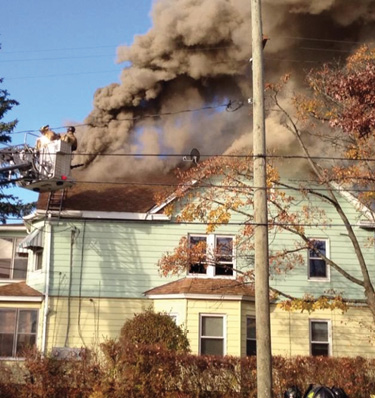
(6) The roof firefighters retreat to the bucket after cutting a vent hole in the roof over a well-involved attic fire. (Photo by Kevin Klett.)
A similar condition exists in parts of the country that are subject to extreme weather—namely the Southeast, where hurricane-rated windows are being installed along the coastal areas. This type of impact-resistant glass can also be found in other areas prone to storm activity and other natural disasters. Because of their robust construction, conventional ventilation methods may be rendered ineffective or, at the very least, inefficient; they necessitate more rigorous efforts, additional equipment, and time.
Wind also greatly limits the use of horizontal ventilation. If a notable wind condition is present, you must control the openings being impacted. “Do not vent windows that would be subject to wind on that face of the building.”9 As little as a 10-mile-per-hour sustained velocity can considerably affect the fire’s behavior and, subsequently, firefighting efforts. Although wind may stifle a horizontal approach entirely (depending on the availability/orientation of the openings), a vertical operation would still be viable since the downwind slope of the roof would not be exposed to the force of the wind. Assessing and communicating the wind velocity, then, are imperative to determine the proper location and, subsequently, the method for opening up.
Tactical Selection
There is more to ventilation than just the exhaust component. To achieve the desired effect, you must account for the intake. The inlet and outlet are mutually dependent to sustain a continuous flow of air. The size and placement of the openings will determine the type and the rate of air exchange. When an outlet is created, there is an immediate equal and opposite reaction (Newton’s Third Law of Motion). Any opening on a plane with or below the fire, with a direct pathway, will serve as an inlet and draw in fresh air to replace the heat and smoke being released. This is a benefit only if the area being vented can be isolated or if water is being effectively applied to the seat of the fire because the additional supply of oxygen will cause the fire to accelerate and the conditions to deteriorate. “… Any size opening to the outside atmosphere will cause the fire to increase and continue its destruction until adequate extinguishing action is taken.”10 Consequently, it is imperative to limit the flow of air to the fire until the onset of the fire attack. Ventilation is not only about creating openings; it is equally about managing openings.
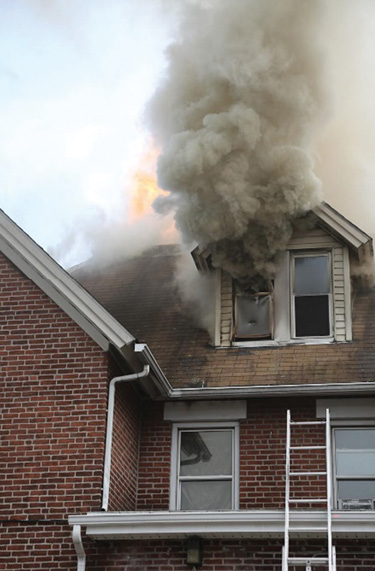
(7) Dormer windows can provide substantial ventilation openings for finished attic spaces. (Photo by Patrick Dooley.)
The “RADE Loop” Decision-Making Model
When determining which of the two methods to employ, it is essential that you have a clear picture of the incident by conducting a thorough and continuous size-up. I devised the “RADE Loop” by fusing the concepts of Colonel John Boyd’s OODA Loop11 with Paul Grimwood’s Tactical Ventilation Strategy12: Read, Anticipate, Determine, Execute.

(8) Large gable vent windows can also provide effective ventilation openings. (Photo by Lloyd Mitchell.)
On arrival, immediately start reading the conditions. Begin with identifying the building construction/layout, height, roof style/pitch, and the (potential) openings. Next, evaluate the presentation of the smoke (volume, velocity, density, color) and fire to determine location and extent. Doing so will also aid in recognizing the inlets and outlets—identifying the existing points of ventilation and their pathway. This is often called “BAG-ing” the fire: locate where the fire has been, where it is at now, and where it is going. The information gleaned will enhance your ability to predict how the fire will react—anticipating how the conditions will progress. Forecasting the fire’s rate of growth, spread, and direction of travel, as well as the structural integrity, is imperative to calculating your operational window and subsequently locating the most advantageous area of operation to aid in the confinement of the fire and the protection of the exposures/survivable space.
Fireground commanders must account for and prioritize the operational demands of the incident and weigh the tactical options against the present resources. After the decision has been made, the plan must be properly communicated. Providing the “commander’s intent” is the key to ensuring it is carried out as intended. (6) Whichever methods you employ, execute the operation in accordance with any established processes (standard operating procedures) and best practices while keeping in tune with your intuition—trust your instincts!13 On completion, the impact must be tracked to gauge its effectiveness and identify any further actions that must be taken.
Figure 1. The RADE Loop

The RADE Loop is a progressive size-up guide that is ideal for ventilation operations. Source: Author.
The importance of a comprehensive and ongoing size-up cannot be overstated. Being able to accurately and concisely evaluate the situation at hand and predict how it will evolve is the very essence of situational awareness and the foundation for sound decision making. As FDNY Deputy Chief (Ret.) Tom Neary always said: “Size-up separates the good ones from the great ones.”14 Each incident we face will present its own unique set of variables, which must be specifically accounted for and addressed, especially with regard to ventilation. The ventilation needs of an incident are conditional and, as a result, highly dynamic. Each building has its own ventilation problems; the correct ventilation technique in one building may not be proper for another.15 In turn, ventilation must be tailored to each incident; there is no stock approach or universal tactic. Regardless of which form of ventilation you use, you must communicate it to all members operating on the fireground, coordinate with the interior crews, and control it to limit the growth and spread of fire. Successful ventilation operations hinge on the presence of competent fireground commanders and skilled operators.
References
1. Kerber, Steve. (2016) Top 20 Tactical Considerations from Firefighter Research. UL-FSRI.
2. LeGear, Dennis. (2017, May 28). Facebook Post. Retrieved from https://www.facebook.com/photo.php?fbid=435139000194824&set= pcb.
435139030194821&type=3&theater.
3. Layman, Lloyd. (1953). Fire Fighting Tactics. NFPA: Boston, MA.
4. FDNY. (2013). Ladders 4: Operations at Private Dwellings.
5. Norman, John. (2012). Fire Officer’s Handbook of Tactics. Pennwell: Tulsa, OK.
6. Willink, Jocko and Babin, Leif. (2016). Extreme Ownership: How Navy Seals Lead and Win. St. Martin’s Press: New York, NY.
7. Dunn, Vincent. (1991). Collapse of Burning Buildings. Fire Engineering: Saddle Brook, NJ.
8. Dunn, Vincent. (1992). Safety and Survival on the Fireground. Fire Engineering: Saddle Brook, NJ.
9. Tracy, Jerry. (2014). Welcome to the Ivy League. FDTN: 18(11).
10. Layman, Lloyd. (1955). Attacking & Extinguishing Interior Fires. NFPA: Boston, MA.
11. Coram, Robert. (2002). Boyd: The Fighter Pilot Who Changed the Art of War. New York, NY: Back Bay Books.
12. Grimwood, Paul. (2017). Euro Firefighter 2. D&M Heritage Press: West Yorkshire, UK.
13. Klein, Gary. (2003). The Power of Intuition: How to use your Gut Feelings to Make Better Decisions at Work. Crown Publishing: New York, NY.
14. FDNY. (2013). Ventilation. Firefighting Procedures: 1(10).
15. Fried, Emanuel. (1972). Fireground Tactics. H. Marvin Ginn Corp: Chicago, IL.
Nicholas Papa is a lieutenant with the New Britain (CT) Fire Department. He is a member of the UL-FSRI technical panel for the study on “Coordinated Fire Attack.” He is also an FDIC International classroom instructor and a co-host of the Fire Engineering podcast, “Politics and Tactics.”

